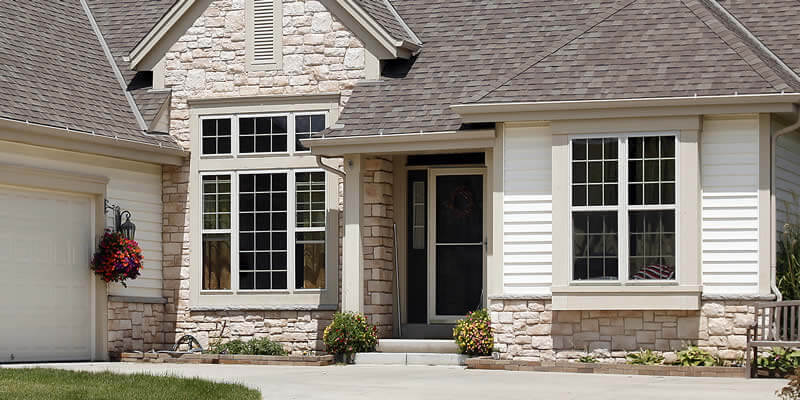Stone Veneer Siding Cost Range
You can expect to pay between $24 and $47 per square foot for stone veneer siding and installation, with higher quality materials and more complicated projects costing more. Natural stone, such as granite or marble, is generally more expensive than man-made faux stone veneer, also called cultured stone veneer.
Average Cost
The average cost of installed stone veneer siding is $33.65 per square foot. The average cost to have 500 square feet of faux stone veneer professionally installed on the interior or exterior of your house is $15,750.
Overview of Stone Veneer, Slate or Faux Stone Siding
Faux stone veneer siding is an affordable alternative to genuine stone, and the appearance and feel are nearly identical. Manufactured stone veneer makes a beautiful complement to log cabin siding for a rustic combination. It also goes beautifully with wood siding, vinyl or aluminum siding, though some homeowners use it to cover an entire exterior surface, the same way it’s done with brick veneer siding. Faux stone siding is just as attractive and versatile indoors where common uses are for fireplaces, hearths and accent walls. You know all this, and that’s why you’re researching stone veneer siding prices.
Here’s something that might be new to you. According to the most comprehensive survey of home remodeling ROI, manufactured stone veneer siding brings an impressive 102.3% return. It is one of the outdoor projects with the highest return on value along with garage door replacement at 102.7% ROI and HVAC conversion to a heat pump.
This cost estimate, or Costimate, breaks down buying options and retail prices for the faux stone and installation materials. Manufactured stone veneer installation costs are detailed for homeowners planning to hire a pro for the work. We’ve gathered cost estimates from reliable sites and encouraged homeowners to share their stone variable speed costs – and you’re welcome to submit your project costs too.
Stone Veneer Siding Cost Factors
The total cost range is broad. These factors should help you narrow the cost for your project.
- Panels vs. Loose Pieces – Panels, typically 2 to 4 square feet, cost more per square foot but install more quickly, so labor costs are lower. Retail prices for both plus labor costs are detailed below.
- Number of Corners – Panels made to wrap corners are 25% to 40% more expensive. If using loose pieces, labor cost is higher due to the time required to cut and piece the stone. The labor cost of installing stone veneer on pillars, chimneys and dormers can be double what it is to cover a wall surface.
- Elevated Work – When the surface to be sided must be reached with a ladder or scaffolding, labor cost will be 25% to 35% higher.
- Removing Old Siding – If this is a siding replacement job rather than new construction, $1.50 to $2.50 per square foot will be added to the estimate for labor and disposal.
- Who Installs the Stone Veneer – Labor accounts for 35% to 55% of the total cost on most jobs. That represents potential savings by installing it yourself. However, there are a lot of issues that can go wrong with installation, and they’re not primarily aesthetic. There’s more under DIY or Hire a Pro?
- Cost of Living – Like everything else, house siding costs are subject to local cost of living.
Cost of Stone Siding and Installation Supplies
This section covers retail costs of stone veneer siding and installation supplies.
There are two methods of installing it. Cement-based pieces and panels are installed using mortar over wire lath and a scratch coat of mortar. The joints are filled with mortar and struck or tooled.
When using this traditional installation method, using a water-resistive barrier, or WRB, over the home’s sheathing is essential. A drainage mat is required too.
Synthetic panels like those made from composite or a polymer like polyurethane have a fastening edge or flange and are installed using screws through the flange to attach them to the home’s sheathing. Installation cost for these panels is much lower because they install relatively quickly.
Faux Stone Veneer Costs
Here is a list of material costs. Your job might not require all of them.
- $8.15 – $10.85 per sq. ft. | Individual Stone Veneer Pieces
- $11.65 – $17.25 per sq. ft. | Stone Veneer Panels
- $1.45 – $2.60 per sq. ft. | Water-resistive Barrier and Drainage Mat
- $1.10 – $1.95 per linear foot | Installation Accessories (Weep Edge, Door/Window Drip Edge, J-channel)
- $0.50 – $1.25 per sq. ft. | Mortar – Premixed Costs More than Unmixed
- $12 – $30 | Trowel Set
- $1.10 – $1.65 per sq. ft. | Wire Lath
About Faux Stone Veneer Siding
Stone veneer siding has many alternate names: faux stone, cultured stone and manufactured stone veneer (MSV) are among the most common. Home inspectors refer to it by the technical name Adhered Manufactured Stone Masonry Veneer (AMSMV).
Material Options
There are two popular types.
The original stone veneer siding is made from a lightweight concrete with additives for strength and to prevent erosion. The material is pigmented (preferred) or painted to mimic the color and shading of genuine stone.
A newer type is made from polymers or plastics and pigmented to resemble genuine stone. Some homeowners think it looks and feels “plasticky,” so we recommend you order samples or view them in a showroom before making your decision.
Both types are offered in a range of attractive colors and styles mimicking round fieldstone, rectangular stacked stone and many others.
Veneer Panels vs Individual Stone Pieces
Faux stone veneer was originally produced in individual pieces, and these are still available. They are installed over wire lath attached to the house and covered by a scratch coat – a thin layer of mortar. A trowel is used to spread mortar on the pieces, and they are set into the scratch coat. Once the faux stones are in place, the gaps are filled with mortar.
The most popular stone veneers are now panels of stones that are attached in one piece to the home. Both cement-based panels with integrated mortar and composite or polyurethane panels are available.
Stone Veneer Water Issues
Cement-based manufactured stone veneer is generally considered more authentic in appearance. But it comes with the inherent risk of water damage. To avoid the risk, a water-resistive barrier and drainage system must be installed because water migrates through concrete.
InterNACHI, or the International Association of Certified Home Inspectors discusses the pros and cons of concrete-based faux stone veneer and shares this warning, “Water damage due to incorrect installation is a significant area of concern, and inspectors and homeowners alike can benefit from knowing how this can occur.” See the article for full details.
Without drainage and a barrier, moisture will get trapped behind the siding, wet the wood framing of the house and cause severe rot damage. Horror stories about stone veneer siding jobs gone bad are easy to find. This is the reason.
This technical bulletin from the Brick Industry Association was written with brick veneer in mind. It applies to proper faux stone veneer installation too. Definitely read it if you plan DIY installation, and it wouldn’t be a bad idea to discuss it with pro installers you talk to before hiring one.
Polyurethane and composite panelized faux stone veneer is not as susceptible to water damage of this type, but house wrap must be used behind it. The key is to follow installation instructions to a “T” to make sure the seams are tight and, with some siding, properly caulked.
Stone Veneer Siding Cost by Area Size & Type
This table gives cost ranges for the size of the area covered based on real-life siding projects.
| Type |
Area Size
|
Cost Range |
|---|---|---|
| Faux Stone | 500 square feet | $12,500 – $18,000 |
| Faux Stone | 1000 square feet | $24,000 – $34,500 |
| Faux Stone | 1,500 square feet | $35,000 – $51,000 |
| Real Stone | 500 square feet | $17,500 – $23,500 |
| Real Stone | 1000 square feet | $37,000 – $46,500 |
| Real Stone | 1500 square feet | $53,500 – $67,500 |
Permits, Inspection, Related Costs and Installation Time
Permits and Inspection Cost
- $0 | A permit isn’t needed.
Labor Costs and Installation Time
Stone veneer installation cost estimates factor materials and the time needed to complete the work. The factors above are considered including the type of material and complexity of the work.
We’ve listed material costs. Here are typical labor cost ranges.
- $6.50 – $9.00 per square foot | Installation of stone veneer panels
- $10.50 – $14.00 per square foot | Single-story installation of faux stone pieces
- $12.50 – $19.00 per square foot | Two-story Installation
- $16.00 – $24.00 per square foot | Installation with Special Considerations (Pillars, Dormers, Porches, Stoops, Complex Hearth/Fireplace Designs)
Installation of panelized stone veneer goes much faster than installing pieces. Here’s what you can expect when 500 square feet of faux stone veneer is installed by a 2-person crew:
- Up to 1 Day | Remove old siding, if needed, and prepare the wall by installing house wrap and drainage material as needed.
- Half Day to 1 Day | Install 500 square feet of panels
- 1-2 Days | Install 500 square feet of pieces
Exterior and Siding Related Projects
Are You a Stone Veneer Siding Installer?
If so, head over to our Costimates Pro’s page, and help us make this page better and more accurate for both our visitors and your future customers.
DIY or Hire a Pro?
If you choose panels of composite or polymer stone veneer, installation is easier with less risk. If you’ve got good basic skills and attention to detail, consider installing it whether your project is indoors or outside.
Follow the instructions that come with the material. Many manufacturers have produced installation videos like this one from TandoStone.
We recommend professional installation for cement-based stone veneer siding on the exterior of a home due to the potential for drainage problems and water damage.
Water damage isn’t an issue when installing cement-based faux stone indoors. The risk is that the job might not look professional. It comes down to your skills or the desire to acquire new ones.
The nice thing about stone, especially fieldstone, is that lines don’t have to run perfectly level, as they do with brick veneer. There’s a randomness to the design. Fieldstone needs to run straighter, but it’s more forgiving than brick too.


 Steve Hansen, that's me, the Senior Editor of Costimates. (
Steve Hansen, that's me, the Senior Editor of Costimates. (